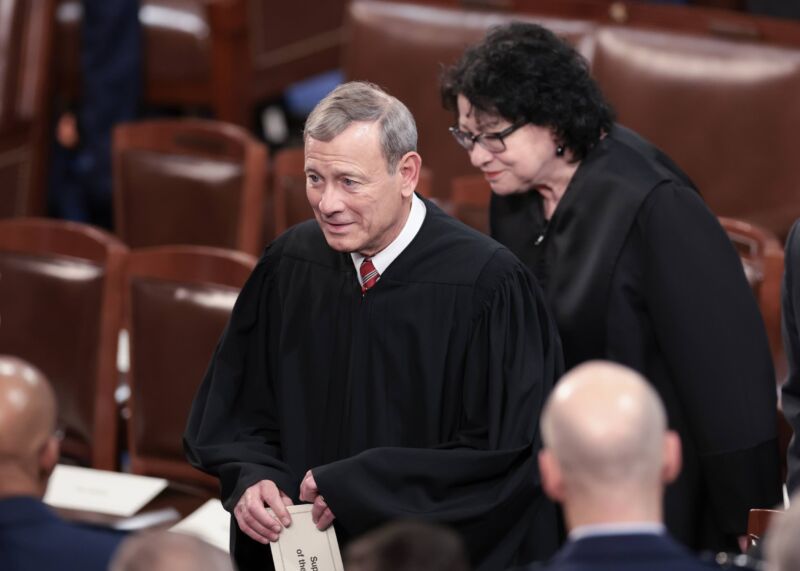
Getty Images | Win McNamee
The US Supreme Court today overturned the 40-year-old Chevron precedent in a ruling that limits the regulatory authority of federal agencies. The 6-3 decision in Loper Bright Enterprises v. Raimondo will make it harder for agencies such as the Federal Communications Commission and Environmental Protection Agency to issue regulations without explicit authorization from Congress.
Chief Justice John Roberts delivered the opinion of the court and was joined by Clarence Thomas, Samuel Alito, Neil Gorsuch, Brett Kavanaugh, and Amy Coney Barrett. Justice Elena Kagan filed a dissenting opinion that was joined by Sonia Sotomayor and Ketanji Brown Jackson.
Chevron gave agencies leeway to interpret ambiguous laws as long as the agency’s conclusion was reasonable. But the Roberts court said that a “statutory ambiguity does not necessarily reflect a congressional intent that an agency, as opposed to a court, resolve the resulting interpretive question.”
“Perhaps most fundamentally, Chevron‘s presumption is misguided because agencies have no special competence in resolving statutory ambiguities. Courts do,” the ruling said. “The Framers anticipated that courts would often confront statutory ambiguities and expected that courts would resolve them by exercising independent legal judgment. Chevron gravely erred in concluding that the inquiry is fundamentally different just because an administrative interpretation is in play.”
This is especially critical “when the ambiguity is about the scope of an agency’s own power—perhaps the occasion on which abdication in favor of the agency is least appropriate,” the court said. The Roberts opinion also said the Administrative Procedure Act “specifies that courts, not agencies, will decide ‘all relevant questions of law’ arising on review of agency action—even those involving ambiguous laws,” and “prescribes no deferential standard for courts to employ in answering those legal questions.”
Kagan: SCOTUS majority now “administrative czar”
The Loper Bright case involved a challenge to a rule enforced by the National Marine Fisheries Service. Lower courts applied the Chevron framework when ruling in favor of the government.
Kagan’s dissent said that Chevron “has become part of the warp and woof of modern government, supporting regulatory efforts of all kinds—to name a few, keeping air and water clean, food and drugs safe, and financial markets honest.”
Ambiguities should generally be resolved by agencies instead of courts, Kagan wrote. “This Court has long understood Chevron deference to reflect what Congress would want, and so to be rooted in a presumption of legislative intent. Congress knows that it does not—in fact cannot—write perfectly complete regulatory statutes. It knows that those statutes will inevitably contain ambiguities that some other actor will have to resolve, and gaps that some other actor will have to fill. And it would usually prefer that actor to be the responsible agency, not a court,” the dissent said.
The Roberts court ruling “flips the script: It is now ‘the courts (rather than the agency)’ that will wield power when Congress has left an area of interpretive discretion,” Kagan wrote. “A rule of judicial humility gives way to a rule of judicial hubris.”
Kagan wrote that the court in recent years “has too often taken for itself decision-making authority Congress assigned to agencies,” substituting “its own judgment on workplace health for that of the Occupational Safety and Health Administration; its own judgment on climate change for that of the Environmental Protection Agency; and its own judgment on student loans for that of the Department of Education.”
Apparently deciding those previous decisions were “too piecemeal,” the court “majority today gives itself exclusive power over every open issue—no matter how expertise-driven or policy-laden—involving the meaning of regulatory law,” Kagan wrote. “As if it did not have enough on its plate, the majority turns itself into the country’s administrative czar. It defends that move as one (suddenly) required by the (nearly 80-year-old) Administrative Procedure Act. But the Act makes no such demand. Today’s decision is not one Congress directed. It is entirely the majority’s choice.”
The unanimous 1984 SCOTUS ruling in Chevron U.S.A. Inc. v. Natural Resources Defense Council involved the Environmental Protection Agency and air pollution rules. Even with Chevron deference in place, the EPA faced limits to its regulatory power. A Supreme Court ruling earlier this week imposed a stay on rules meant to limit the spread of ozone-generating pollutants across state lines.
Consumer advocacy group Public Knowledge criticized today’s ruling, saying that it “grounds judicial superiority over the legislative and executive branches by declaring that the Constitution requires judges to unilaterally decide the meaning of statutes written by Congress and entrusted to agencies.”
Public Knowledge Senior VP Harold Feld argued that after today’s ruling, “no consumer protection is safe. Even if Congress can write with such specificity that a court cannot dispute its plain meaning, Congress will need to change the law for every new technology and every change in business practice. Even at the best of times, it would be impossible for Congress to keep up. Given the dysfunction of Congress today, we are at the mercy of the whims of the Imperial Court.”
